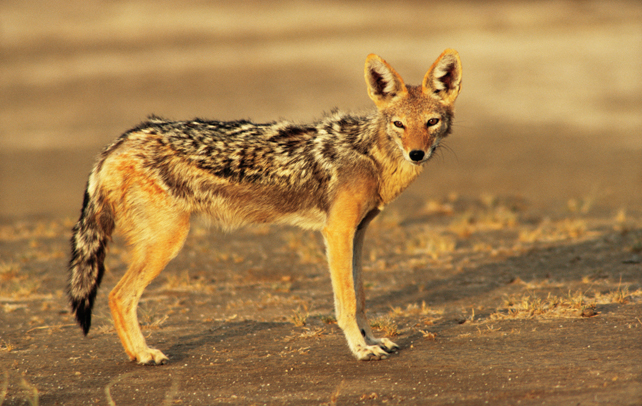Interesting Facts About Jackal

“When the tiger kills, the jackal profits”, this old proverb portrays jackal in a very poor light as a mere scavenger. They are in fact very fascinating animals that will engage you ever more, once you start knowing about their interesting way of life. The jackal is a medium sized dog-like omnivore with a bushy tail and is found in Africa, Asia, and south-eastern Europe. Generally living in a pack of 10 to 30 individuals, they coordinate very well socially. Like other canid species, the jackal is well built and muscular runner with long legs. Staying in group works in their favour because they can hunt bigger animals, like the Thomson’s gazelle and can even protect one another, when threatened by enemies. They have also been venerated as Gods in ancient mythologies of Greece and Egypt. Over the ages they have been very successful in adapting to changing environment. Read on to know more about the creature.
Fast Facts
Scientific Name: Golden Jackal (Canis aureus), Side-striped Jackal (Canis adustus), and Black-backed Jackal (Canis mesomelas)
Kingdom: Animalia
Phylum: Chordata
Class: Mammalia
Order: Carnivora
Family: Canidae
Genus: Canis
Species: 3 species (Canis aureus, Canis adustus, Canis mesomelas)
Size: 15 to 20 inches (at the shoulder)
Weight: 15 to 35 pounds
Life Span: 10 to 12 years
Habit: Live single or in pairs
Diet: Omnivorous, scavenger
Habitat: Open and wooded savannahs, desert, and arid grasslands
Call: Yell and yapping
Gestation Period: Around 2 months
Number of Offspring: 2 to 4 pups
Predators: Eagles, hyenas, and leopards
Interesting And Fun Facts About Jackal
- According to the traits ingrained in jackals’ behaviour, they make interesting and varying sounds. These sounds are meant to communicate with each other by yell, yap, or distinctive siren-like howl. Moreover, the sound also alerts others when a kill is located.
- Although jackals are considered as scavengers but they are known to hunt and kill number of preys.
- The mother jackal changes the den site in every two weeks to protect the pups from probing predators.
- The three major species of jackal found worldwide are: Golden jackal (Canis aureus), Side-striped jackal (Canis adustus), and Black-backed jackal (Canis mesomelas). These species differ from each other in colour and choice of habitat.
- Among all the species of jackals, the golden jackal is the most common that can be found from East Africa to Burma. Although in east Africa the Golden, Silver-backed, and Side-striped jackals are found together, but they occupy different habitats.
- Golden jackals are not closely related to the other species rather they possess similar characteristics as that of wolf and coyote.
- The golden jackal or the Asiatic jackal is the heaviest jackal in the world, weighing almost 35 pounds.
- The species of black-backed jackal like to have a den with multiple exits.
- From the three species of jackal, side-striped jackal is the least aggressive while the most aggressive one is the black-backed jackal.
- An infant jackal takes around 10 days to open its eyes.
- Jackals are very territorial in nature and zealously protect their area.
- Yearlings or the little grown up pups take care of the new born jackals. Most pup deaths occur during the first 14 weeks of birth and therefore it is necessary to get a guardian’s help in order to increase the survival rate.
- The side-striped jackals, found around the regions of savannah and woodlands, produce sound that is similar to the hoot of an owl rather then howling.
- The golden jackal is known to have 12 subspecies.
- The golden jackal is known by many names; such as, Oriental Jackal, Common Jackal, Asiatic Jackal, Reed Wolf, and Astro-Hungarian Wolf.
- In case of unavailability of food, the jackal, especially those found in the tropics of Southeast Asia can survive by feeding on grass.
- Jackals are crepuscular mammals: they are most active during the time of dawn and dusk.
- Jackals are known to be vigorous runners and can run at the speed of 16 km/hr for a long time.
- They commonly use sounds like yelling and yapping to communicate with the other members of the pack.
- Till the age of 2 months the infant jackal is nurtured by its mother. When the young one reaches 6 months, it becomes ready to hunt on its own.
- Jackal is among those mammalian species that mate for life.
- Jackals can hunt small mammals, birds, and reptiles.
- Hyenas, leopard, and eagles are the jackals’ most common predators. Eagles are known to prey on pups.
- Some species of jackal have been known to eat poisonous snakes.
- Both the sexes of jackal mature at 11 months, although they might not consider mating for some time.
- Jackals pose agricultural threat to man due to which they are killed. They are also known to be hunted for their fur.
- The simien jackal that is native to Ethiopia is endangered specie with only around 500 of them left in the world.
- In a bid to keep heat at bay, jackals prefer to live and sleep in deep crevices in rocks and dens constructed by other animals.
- The Eastern myths depict jackals and foxes as clever sorcerers.
- The ancient Egyptian god associated with mummification and afterlife was named as Anubis: a Greek word which means jackal-headed god.
- During the inbreeding experiment of jackals with poodles, the jackal-dog hybrids were found out to be less fertile as compared to the wolf-dog hybrids.









